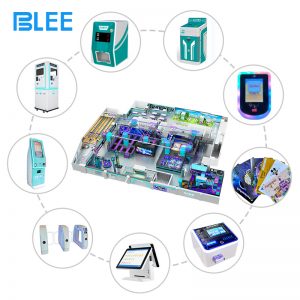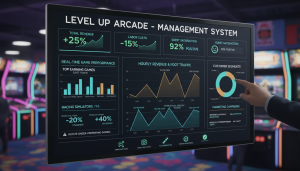Introduction
Building a profitable arcade center from the ground up requires a well-executed plan that balances entertainment appeal with operational efficiency. Leveraging a full turnkey solution can streamline the entire process—from selecting games and designing the layout to meeting compliance and optimizing cash flow. This guide explores essential challenges like choosing the right machine mix, infrastructure setup, regulatory compliance, and realistic revenue modeling.
At the forefront of turnkey solutions, BLEE stands as a global leader, supplying certified arcade equipment with extensive turnkey services tailored for Family Entertainment Centers (FEC). You will find in this guide a pragmatic, revenue-focused blueprint driven by numbers and real-world experience to help you build a successful arcade.
1. Understanding the Turnkey Arcade Concept
1.1 What Is a Full Turnkey Arcade Center?
A full turnkey arcade center encompasses everything required to launch a gaming venue from concept to opening day. This includes comprehensive planning, sourcing and supplying arcade machines, installation, ensuring compliance with standards like CE and RoHS, and final system testing for operational readiness. Unlike a DIY or piecemeal approach where separate vendors and contractors handle different tasks, a turnkey solution provides a unified, single-source offering that reduces complexity and risk.
1.2 Benefits of a Turnkey Solution
Opting for a turnkey approach accelerates your time to market by minimizing rework, ensuring all components fit together seamlessly. Moreover, turnkey providers integrate regulatory compliance and after-sales support, vital for long-term operation. This integration extends to optimizing your arcade’s revenue potential with an expert-selected machine mix and efficient layout design to maximize guest throughput.
1.3 BLEE’s Turnkey Offering in the Global Arcade Market
BLEE supplies a wide range of high-quality arcade and FEC equipment, including VR games, redemption machines, simulators, and sports games, fully customizable to your market needs through OEM/ODM services. Their logistics network ensures reliable global delivery, installation, and post-launch support. For example, BLEE successfully deployed a 600 sqm turnkey arcade in a major mall, integrating compliance, visitor flow design, and targeted revenue zones.
2. Reverse-Engineering Your Arcade for Profitability
2.1 Starting with the Revenue Map: Weekly Cashflow Target
Before choosing equipment or layouts, define realistic weekly revenue targets by game category such as redemption, video games, VR attractions, and sports zones. Use demographic data, foot traffic estimates, and seasonal trends to model earnings. This upfront arcade investment guide helps tailor your arcade turnkey solution to local conditions, maximizing profitability.
2.2 Engineering Machine Mix for Maximum Throughput and ROI
Selecting the right machine mix is crucial: quality trumps quantity. Forty thoughtfully chosen machines will outperform seventy mismatched units. BLEE’s certified product sets come with proven revenue yields per type, helping streamline your decision.
| Machine Type | Avg. Weekly Revenue per Sqm ($) | Typical ROI (Months) |
|---|---|---|
| Redemption Games | 120 | 10-12 |
| VR & Simulators | 150 | 8-10 |
| Sports Games | 110 | 12-14 |
This table helps operators forecast earnings and prioritize categories for their arcade layout planning.
2.3 Planning the Floor Layout: Zoning for Performance and Compliance
Successful layout divides the arcade into revenue zones—high throughput areas for popular machines, alongside family-friendly zones encouraging longer visits. Acoustic zoning manages noise levels, enhancing guest comfort and compliance with regulations. Accessibility standards are integral to design, ensuring inclusivity.
2.4 Utilities & Infrastructure Backplanning
Infrastructure planning begins with precise electrical load calculations compliant with CE and RoHS standards, to avoid costly retrofits. Consider power distribution, noise insulation, and ventilation for player safety and machine longevity. Incorporating cashless payment systems not only increases customer spend by up to 600% per session but improves operational efficiency and data insights.
3. Step-by-Step Arcade Setup Checklist 2024
3.1 Site Selection and Leasehold Preparation
Location is crucial: prioritize high foot traffic areas with favorable lease terms. Prepare leaseholds by assessing renovation requirements including flooring, walls, lighting, and utility upgrades necessary for compliant arcade operations.
3.2 Equipment Procurement and Batch Delivery Planning
Procure machines aligned with your client demographic through pre-bundled launch packs from reputable FEC equipment suppliers. Manage batch deliveries closely to mitigate supply chain risks, ensuring installation timelines stay on track.
3.3 Compliance and Permitting
Navigating CE, RoHS, and ISO certifications is imperative, coupled with meeting local safety, accessibility, and environmental regulations. Compliance checklists should be integrated early to avoid costly delays.
3.4 Staffing and Operational Readiness
Recruit optimally sized teams for launch and planned growth phases. Training schedules must include customer service, safety protocols, and routine maintenance to maintain uptime.
3.5 Marketing and Launch Execution
Develop launch events that attract diverse customer segments with loyalty and redemption programs designed to boost return visits.
4. Financial Modeling and Budget Planning for Arcade Investment
4.1 Estimating Arcade Setup Cost Breakdown
Costs vary widely by arcade size. Typically, small venues start around $50,000 while mid-size centers range $250,000-$1 million, and large arcades can exceed $1 million. These figures include machines, renovations, staffing, and marketing.
| Cost Category | Small Arcade ($) | Mid-size Arcade ($) | Large Arcade ($) |
|---|---|---|---|
| Arcade Machines | 20,000 – 50,000 | 50,000 – 500,000 | 500,000+ |
| Renovation & Fit-out | 10,000 – 40,000 | 20,000 – 300,000 | 300,000+ |
| Staffing & Operations | 10,000 – 30,000 | 30,000 – 150,000 | 150,000+ |
| Marketing & Launch | 5,000 – 15,000 | 15,000 – 75,000 | 75,000+ |
This breakdown is essential for creating a realistic FEC budget planning and securing investment.
4.2 Arcade ROI: Metrics that Matter
Key performance metrics include redemption payout percentages and profit per square meter. A common approach is to keep redemption payout rates around 30-40% to balance guest satisfaction and profitability. Expect cashflow to ramp up gradually post-launch, with break-even achievable between 12 to 18 months depending on scale and location.
4.3 Budget Planning and Risk Mitigation Strategies
Incorporate contingency reserves to cover unforeseen expenses and schedule delays. BLEE’s phased 3-30-90 day launch support stabilizes uptime by addressing initial operational hiccups proactively.
5. Technology and Innovation in Modern Arcade Centers
5.1 Cashless Payment Systems and Their Impact
Cashless payment adoption is transforming the arcade industry. Players tend to spend up to 600% more per session using cards and mobile wallets. These systems lower cash handling costs, improve customer satisfaction, and offer operators valuable data for targeted upselling and loyalty schemes.
5.2 The Role of VR and Interactive Simulators
VR and interactive simulators add an innovative edge and higher-margin offerings to your arcade. However, they require careful planning for space, power, and trained staff to deliver safe, engaging experiences.
5.3 Planograms and Retail Optimization Principles
Applying retail planogram principles maximizes revenue per square meter. Strategic placement of machines encourages player flow and engagement, balancing crowd density and ease of access. Such optimization boosts overall arcade ROI and guest satisfaction.
6. Case Study: BLEE’s Complete Turnkey Arcade in a 600 sqm Mall Site
6.1 Project Overview and Objectives
BLEE conducted detailed demographic analysis and revenue target setting for a 600 sqm location within a busy mall zone. Zoning prioritized high-traffic redemption and family areas, with carefully configured launch packs aligned to the local market.
6.2 Execution Highlights
Equipment was produced with custom features and delivered on schedule. Electrical infrastructure met all CE and RoHS requirements. Installation along with staff training was completed within three weeks, ready for opening.
6.3 Results and Lessons Learned
Post-launch revenue met 95% of forecasts by month three, demonstrating the accuracy of the data-driven approach. Customer engagement was high, supported by effective loyalty programs and operational uptime exceeded 98%. The turnkey model allowed rapid problem resolution with reliable parts logistics.
FAQ
Q1: What is included in an arcade turnkey solution?
Turnkey solutions cover everything from site planning, equipment supply, installation, compliance certification, to after-sales support.
Q2: How do I calculate the optimal machine mix for my arcade?
Start with your weekly revenue targets by game category, then design layout and electrical plans backward to fit the right machines for throughput and ROI.
Q3: What are the typical costs involved in setting up a complete arcade center?
Costs vary by size: small setups can start at $50,000, midsize $250k-$1M, and large venues exceeding $1M, including machines, staffing, renovation, and marketing.
Q4: How important is compliance with CE and RoHS in arcade equipment?
Compliance ensures safety, legal operation, and environmental standards adherence, essential for operation in Europe and many global markets.
Q5: Can cashless payment systems improve arcade profitability?
Yes, cashless systems boost revenue significantly by increasing customer spend per session and streamlining operations.
Q6: What factors should be considered when selecting an arcade location?
High foot traffic, lease conditions, accessibility, and demographic fit are critical to location success.
Q7: How does BLEE support post-launch operations?
BLEE provides ongoing parts logistics, maintenance support, and operational consulting to ensure uptime and performance.
Q8: What role does layout planning play in arcade success?
Effective layout improves traffic flow, guest experience, and compliance, directly impacting revenue and safety.
Q9: How can I mitigate investment risks in arcade setup?
Use phased launch plans, contingency budgets, and choose experienced turnkey partners to reduce risk.
Q10: What innovations can modern arcades include to attract customers?
Incorporating VR, interactive simulators, cashless payment, and data-driven loyalty programs enhances appeal and profitability.






